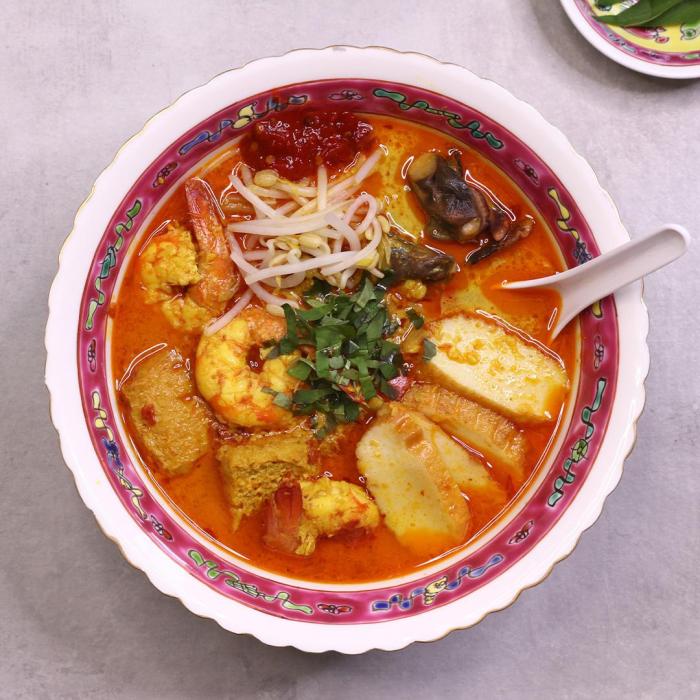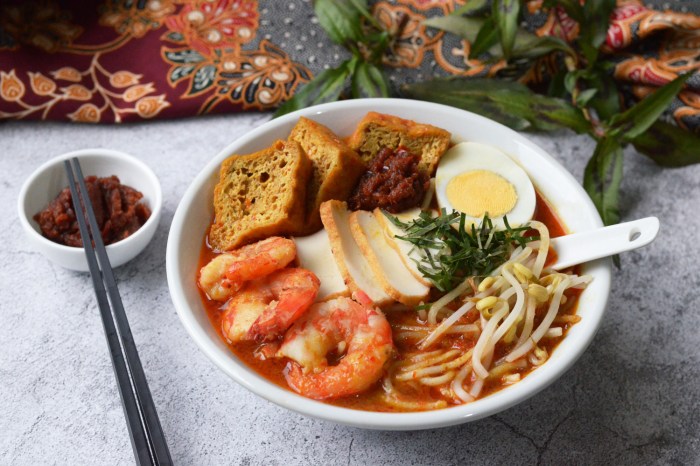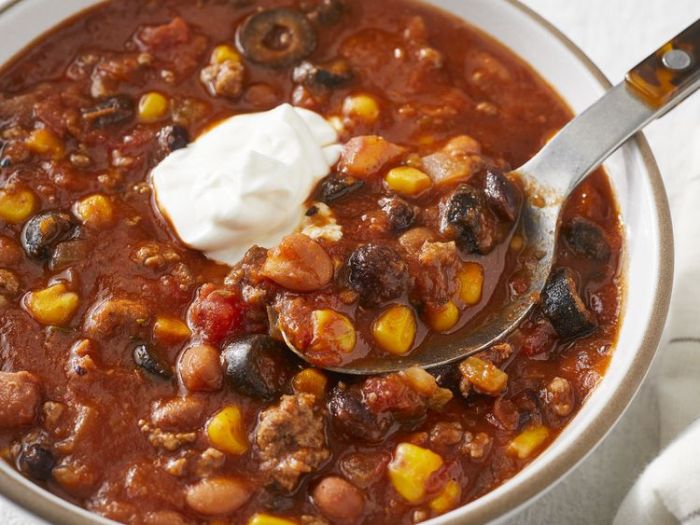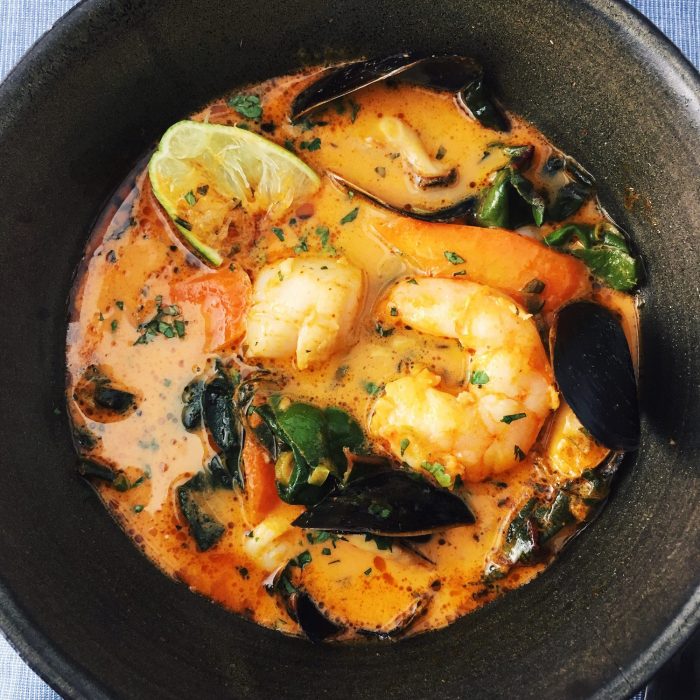Singaporean Laksa: A Culinary Journey: Recipe For Laksa Soup From Singapore

Source: buzzfeed.com
Recipe for laksa soup from singapore – Laksa, a vibrant and flavorful noodle soup, holds a special place in Singaporean cuisine, reflecting the nation’s rich multicultural heritage. Its origins are debated, with influences from various cultures converging to create the unique variations found today. This article delves into the world of Singaporean Laksa, exploring its history, ingredients, preparation, and diverse interpretations.
Introduction to Singaporean Laksa, Recipe for laksa soup from singapore
Singaporean Laksa’s history is a delicious tapestry woven from threads of Chinese, Malay, and Peranakan influences. While the exact origins remain unclear, its popularity exploded in the 20th century, becoming a staple in hawker centers and restaurants across the island nation. The dish’s cultural significance is undeniable; it’s not just a meal, but a representation of Singapore’s melting pot identity and culinary innovation.
Two primary variations dominate the Singaporean Laksa landscape: Katong Laksa and Curry Laksa. Katong Laksa, originating from the Katong district, is known for its rich, creamy coconut milk-based broth and its use of thick, flat rice noodles. Curry Laksa, on the other hand, boasts a spicier, thicker, and more intensely flavored curry broth, often featuring vermicelli noodles. Subtle variations within each type exist, reflecting the unique styles of individual cooks and establishments.
Key differences between Singaporean Laksa and its counterparts in other regions often lie in the broth’s base and spice profile. Malaysian Laksa, for instance, features variations such as Assam Laksa (sour and tamarind-based) and Penang Laksa (a richer, spicier curry version). Indonesian Laksa also showcases unique regional flavors. Singaporean Laksa, however, is characterized by its distinct balance of spice, creaminess, and the use of specific ingredients and noodle types that set it apart.
Essential Ingredients for Laksa Soup
The following ingredients list provides quantities for a delicious Laksa serving four people. The careful selection and proportioning of these ingredients are crucial in achieving the authentic taste and aroma of Singaporean Laksa.
| Category | Ingredient | Quantity | Notes |
|---|---|---|---|
| Spices | Dried chilies | 10-15 | Adjust to desired spiciness |
| Spices | Lemongrass | 2 stalks | Bruised |
| Spices | Galangal | 1 inch piece | Peeled and roughly chopped |
| Spices | Turmeric | 1 tbsp | Powdered |
| Spices | Cumin | 1 tsp | Powdered |
| Aromatics | Shallots | 5-6 medium | Peeled |
| Aromatics | Garlic | 4-5 cloves | Peeled |
| Aromatics | Ginger | 1 inch piece | Peeled and roughly chopped |
| Proteins | Chicken breast or prawns | 400g | Cut into bite-sized pieces |
| Noodles | Thick rice noodles or vermicelli | 400g | Soaked according to package instructions |
| Other | Coconut milk | 400ml | Full-fat recommended |
| Other | Fish sauce | 2 tbsp | Adjust to taste |
| Other | Sugar | 1 tbsp | Adjust to taste |
| Other | Vegetable oil | 2 tbsp | For sautéing |
| Other | Water | 1 litre | Adjust as needed |
| Other | Kaffir lime leaves | 2-3 | Adds a unique citrusy aroma |
Each ingredient plays a vital role. The spices create the depth and complexity of the broth, the aromatics add fragrant layers, the protein provides substance, and the noodles form the foundation of the dish. The coconut milk lends creaminess, while fish sauce and sugar balance the flavors.
Step-by-Step Cooking Process
The preparation of Laksa involves a series of steps that build upon each other to create a harmonious blend of flavors and textures. Precision in each step contributes to the final product’s success.
- Spice Paste Preparation: Blend dried chilies, lemongrass, galangal, turmeric, cumin, shallots, garlic, and ginger into a smooth paste. The aroma at this stage is intensely fragrant, with a hint of spice and citrus. The texture should be thick and slightly oily.
- Sautéing Aromatics: Heat oil in a pot, add the spice paste and sauté until fragrant and slightly darkened in color (around 5 minutes). The aroma intensifies, becoming more pungent and inviting.
- Simmering the Broth: Add water, coconut milk, fish sauce, sugar, and kaffir lime leaves to the pot. Bring to a boil, then reduce heat and simmer for at least 15 minutes. The broth will gradually thicken and deepen in color.
- Adding Protein: Add the protein (chicken or prawns) to the simmering broth and cook until done. Chicken usually takes around 10-15 minutes, while prawns require less time (around 5 minutes).
- Cooking the Noodles: Cook the noodles separately according to package instructions. Once cooked, add them to the soup.
- Serving: Ladle the Laksa into bowls and garnish as desired.
Variations and Adaptations

Source: com.au
Singaporean Laksa offers opportunities for customization and adaptation. Different preferences and dietary needs can be easily accommodated.
- Vegetarian Laksa: Replace chicken or prawns with firm tofu or mushrooms. The broth remains largely the same, offering a hearty and flavorful vegetarian option.
- Spicy Laksa: Increase the quantity of chilies in the spice paste to elevate the heat level. Adding a few slices of fresh chilies to the finished bowl also enhances the spiciness.
- Laksa with additional vegetables: Incorporate vegetables like bean sprouts, bok choy, or long beans for added texture and nutrients. Add these vegetables towards the end of the cooking process to retain their crispness.
Substitutions can be made depending on availability. For instance, if fresh galangal is unavailable, you can use a small amount of ground ginger as a substitute, although the flavor will differ slightly. Similarly, other types of noodles can be used, although the traditional rice noodles are recommended for the best experience.
Serving Suggestions and Garnishes
The presentation of Laksa is as important as its taste. Garnishes not only enhance the visual appeal but also add textural and flavor dimensions.
| Garnish | Flavor Profile | Enhancement | Visual Description |
|---|---|---|---|
| Lime wedges | Tart and citrusy | Cuts through richness, adds brightness | Bright green wedges, contrasting with the soup’s color |
| Fresh coriander | Slightly peppery and herbaceous | Adds freshness and aroma | Bright green leaves, scattered on top |
| Fresh chilies | Fiery and pungent | Increases spiciness | Vibrant red slices, adding a pop of color |
| Fried shallots | Sweet and savory | Adds textural contrast and depth of flavor | Golden brown, crispy shallots scattered on top |
Laksa can be served as a main course, often accompanied by steamed rice or a side of vegetables. The combination of flavors and textures creates a satisfying and unforgettable culinary experience.
Illustrative Descriptions of Key Steps
The visual and aromatic cues during Laksa preparation provide valuable insights into the cooking process.
The spice paste, once blended, exhibits a deep reddish-brown hue, thick and pasty in consistency. Its aroma is pungent, with notes of chili, lemongrass, and ginger, promising the flavorful journey ahead. During sautéing, the paste darkens further, releasing its potent fragrance into the air. The simmering broth gradually transforms from a milky white to a richer, more opaque shade, infused with the deep colors of the spices.
The final Laksa soup presents a vibrant and inviting appearance, a rich, reddish-orange broth teeming with noodles and protein, garnished with fresh herbs and lime wedges. Its aroma is complex and alluring, a blend of spice, coconut, and herbs, complemented by the subtle fragrance of lime. The texture is a delightful interplay of soft noodles, tender protein, and the creamy broth, offering a multi-sensory culinary experience.
User Queries
Can I use pre-made Laksa paste?
Yes, pre-made pastes are available, but making your own offers a more nuanced flavor profile. Adjust the amount to taste if using a pre-made paste.
Crafting a delicious Laksa soup from Singapore requires careful attention to the spice blend. The rich, creamy coconut milk base contrasts beautifully with the vibrant flavors, much like the comforting warmth of a olive garden recipe for chicken gnocchi soup offers a different kind of culinary satisfaction. Returning to the Laksa, remember to adjust the chili level to your preference for the perfect balance of heat and savory goodness.
What type of noodles are traditionally used?
Thick rice vermicelli noodles are most common, but you can also use yellow noodles or even egg noodles for a different texture.
How long can I store leftover Laksa?
Leftover Laksa should be stored in an airtight container in the refrigerator for up to 3 days. Reheat gently before serving.
Can I make this recipe vegetarian/vegan?
Yes, omit the protein (prawns, chicken etc.) for a vegetarian version. For vegan, use coconut milk instead of fish sauce and vegetable broth instead of chicken broth.


